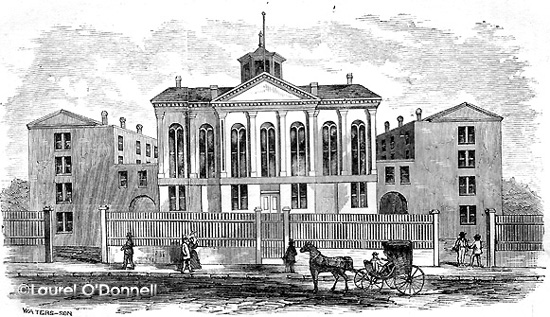|
|
Chapter V
Institutions of Manhattan Island and Westchester Co.
The Colored Home
(Sixty-Fifth Street And First Avenue.)
 THE first meeting for the organization of this excellent charity is believed to have been convened at the residence of Mrs. Maria Banyer, at No. 20 Bond street, in the autumn of 1839. The plan for relieving the suffering poor among the colored population is said to have originated with Miss Shotwell, Miss Jay, the first contributor, generously presenting a thousand dollars towardthe founding of the Home at their first meeting. At a subsequent meeting a board of managers was formed, a constitution adopted, and the organization perfected under the title of "The Society for the Relief of Worthy Aged Colored Persons." It was duly incorporated in 1845, under the title of "The Society for the Support of the Colored Home." Soon after its first organization a building on the North river, known as "Woodside," was opened, and twelve inmates at once received. Through the liberality of Mr. Horsburgh, a property on Fortieth street and Fourth avenue was purchased in 1843. The act of incorporation, in 1845, was followed by a grant of $10,000 from the Legislature, which sum had been previously appropriated toward the erection of a State Hospital in, this city, but was now transferred to the managers of the Colored Home for the erection of permanent buildings. The next year arrangements were made with the Commissioners of the Poor, which still continues to receive, at a very low rate, the colored paupers of the city, unless medically unfit for the Colored Home. Forty-four lots of ground on First avenue, between Sixty-fourth and Sixty-fifth streets, were purchased in 1848, and the following year a portion of the buildings now occupied were completed. The Institution consists of four departments-the Home for Aged and Indigent, the Hospital, the Nursery, and the Lying-in Department. The admissions to the Hospital exceed those of the other three divisions combined. The buildings at present form a hollow square, with a fine flower-garden in the center. Fronting on Sixty-fifth street stands the beautiful brick chapel erected in 1858, under the supervision of the excellent chaplain MacFarlan. The first floor of this building contains a parlor, appropriate apartments for the superintendent, steward, physician, matron, and the dispensary. On the floor above is the chapel, well arranged, with galleries on the sides, and Beatings for six hundred persons. From either end of this building extend at right angles the male and the female wings, four stories high, capable of accommodating a hundred and twenty persons each. Each floor is a ward extending the whole length of the building, and contains twenty-eight beds. These wings are connected in the rear by another two-story building, divided into smaller apartments containing from five to eighteen beds each. This is devoted, in part, to the nursery and the lying-in department, founded by the bequest of Mrs. Jacob Shatzel in 1847. About fifty are annually received into this last-named department, who leave when they are able, some to service in Christian families, others to their old habits of vice and dissipation. The buildings are heated with stoves, and baths with hot and cold water have recently been introduced. The nursery contains children over three years of age, who cannot gain admittance into the Colored Orphan Asylum. The average number in this department is about twenty. The Institution is designed for the colored poor of New York county, yet, when space will allow, persons from outside the county are taken, and pay one dollar and eighty-two cents per week if they require medicine, and if not, one dollar and five cents, three months pay being required in advance. The State appropriated $12,000 to this charity in 1866, in 1867 $3,858, and over $4,000 have since been received from the same source. The Commissioners of Charities and Corrections pay a stipulated price for the board of pensioners admitted under their direction, but this is only a moiety of what is actually expended in their support. The excellent Chauncey Rose remembered the Institution with a bequest of $16,000. About one thousand persons are annually cared for, at an expense of about $30,000. Dr. James D. Fitch held the position of resident physician twenty-six years. The Institution has a chaplain, a resident, a house, and an assistant house physician, which receive a trifling pecuniary compensation for much earnest labor. Many of the inmates are very old, some pressing into their second century. Most of the inmates are pious, and, as the majority of them are Methodists, the chaplain is selected from that denomination, though ministers and missionaries from all evangelical churches are always well received. The inmates hold prayer-meetings in their rooms, in addition to the regular services. Every winter a Christmas tree grows up suddenly, whose prolific branches bring forth something nice for every inmate, which is received with great joy. On these occasions addresses are delivered by some of the prominent men of New York, and this holiday period is remembered with much interest all the year. |
|
220
:: Previous Page :: Next Page ::
:: Table of Contents :: :: New York State :: :: History Readings :: Books & articles appearing here are modified adaptations
from a private collection of vintage books & magazines. Reproduction of these pages is prohibited without written permission. © Laurel O’Donnell, 1996-2006.
|
|

